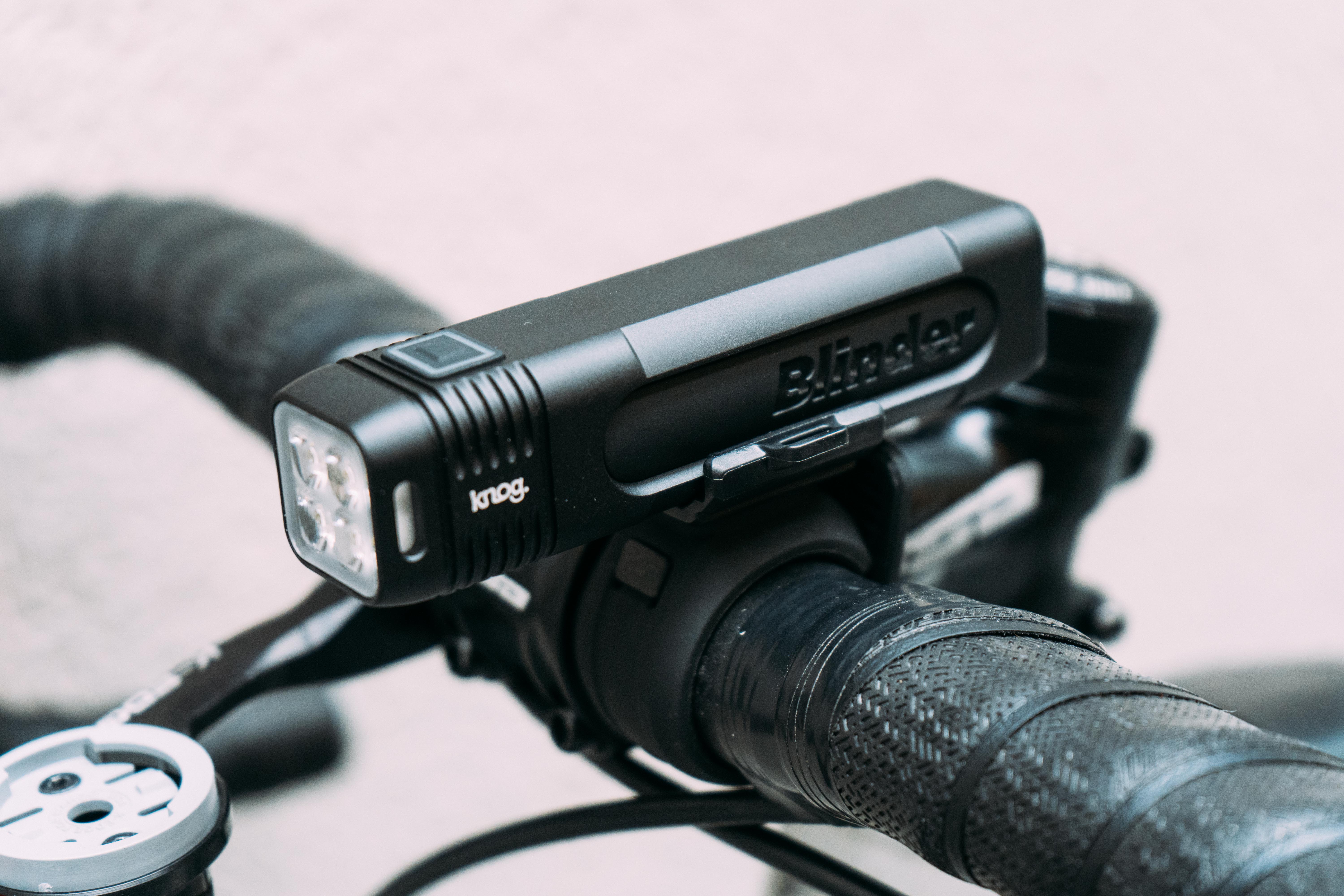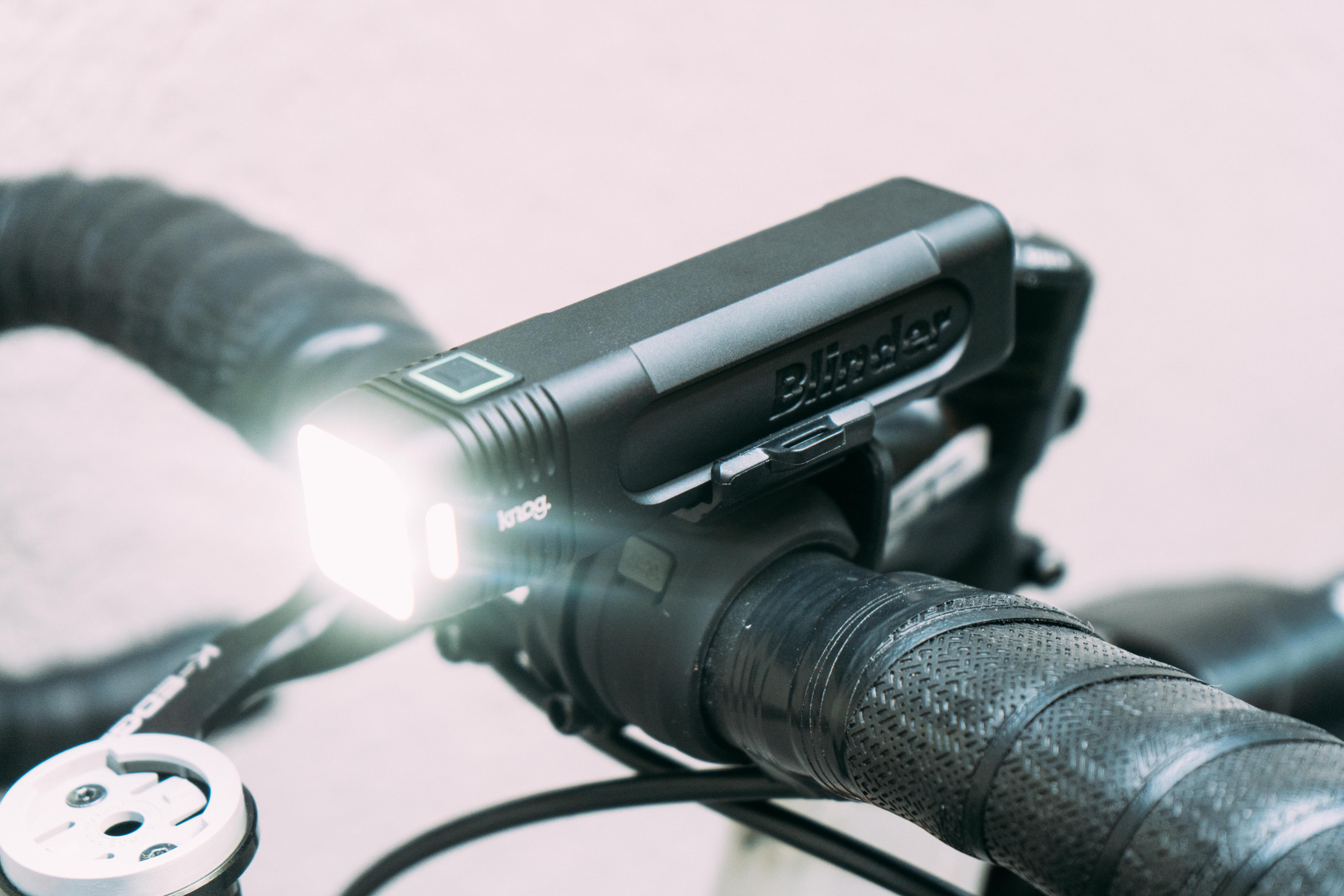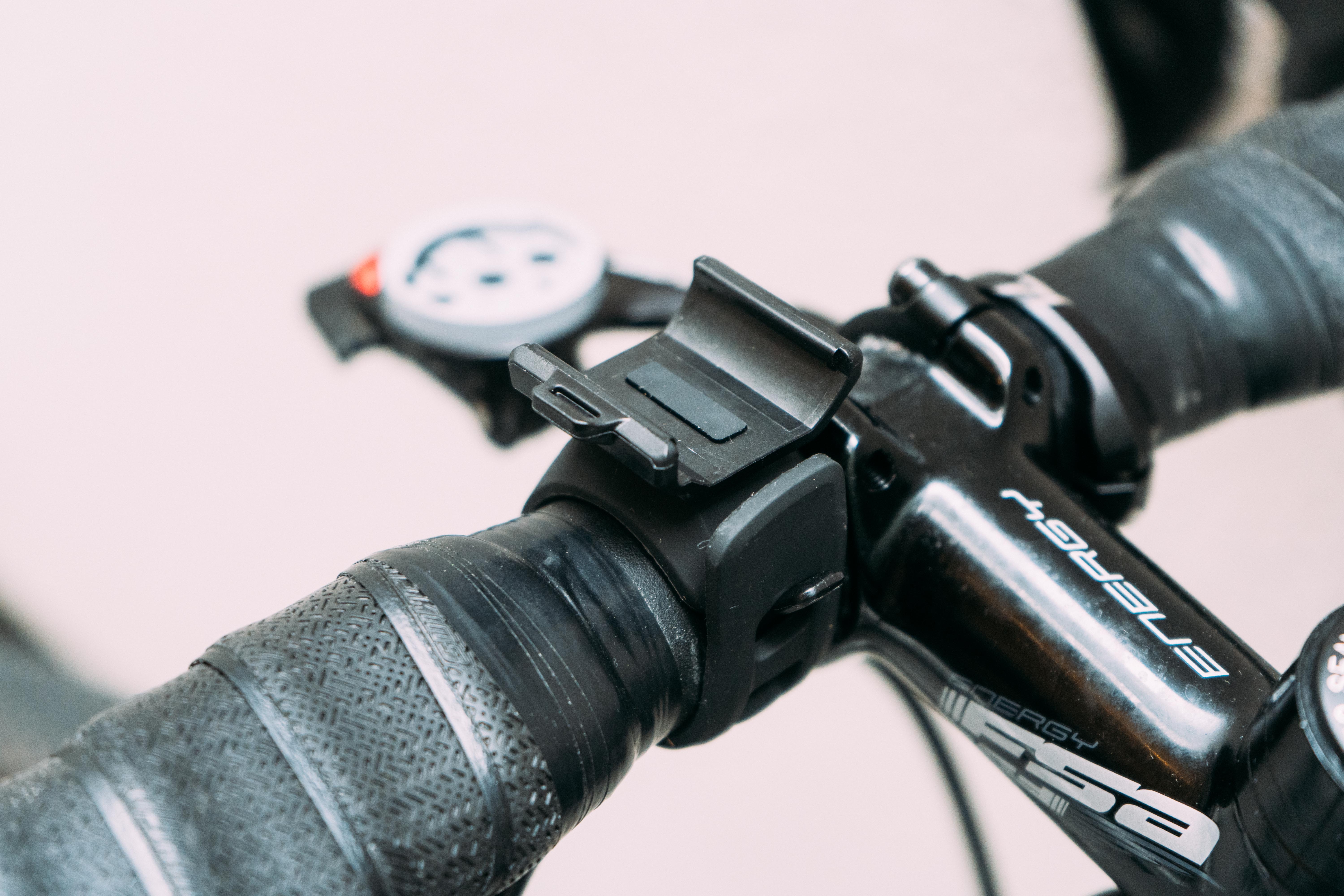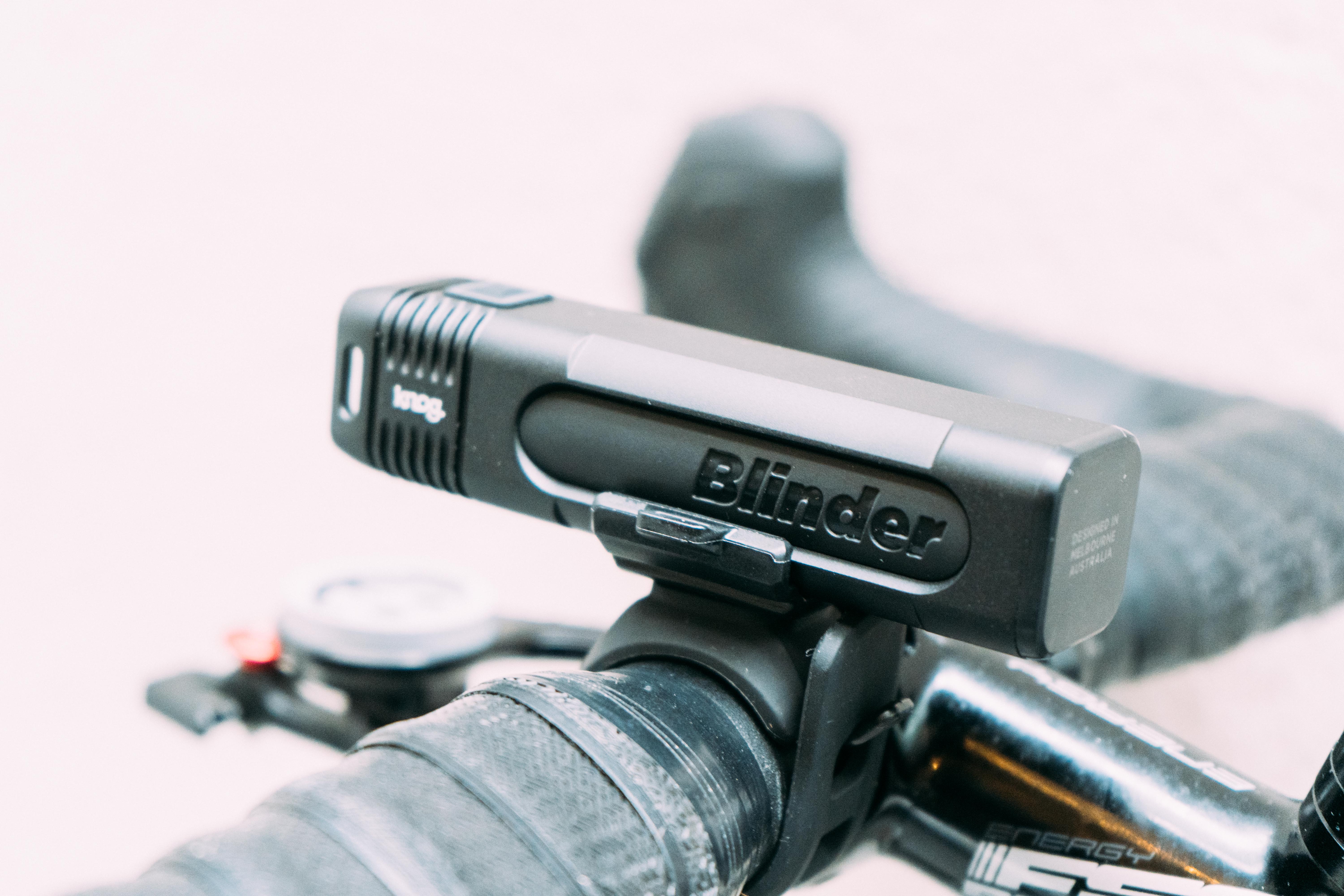
Price: £59.99 / €59.95 / $59.95
Lumens: 600
Modes: 6
Battery life: 2 hours full beam, 120 hours Eco Flash
Weight: 155g claimed, 137g (just light), 158g light and mount
The Knog Blinder Pro 600 sits in the brand’s revamped Blinder line of lights. The Pro models feature a revised design and new battery tech, while also becoming cheaper per lumen than the previous Blinder range of lights. A Blinder 900 and 1300 lumen option are also available.
A CNC-machined 6061 aluminum body and elongated profile give it a sleek look. The star of the show is the new battery tech, similar to what Tesla uses, offering the best power-to-weight in terms of battery performance according to Knog.
Using two wide and two narrow beam bulbs, it offers a great range of illumination when riding. At £59.99, the price puts it a little higher than the likes of the Lezyne Fusion Drive Pro 600+, and similar to the Cateye AMPP 800. However, with an aluminium body, it’s a fair bit cheaper than the comparable offerings from Exposure Lights.
But how does that premium finish stack up with the performance level of this light?

Design and specifications
The Knog Blinder range of lights have been around for a good while now, but the latest iteration of Blinder Pro lights changes up a lot of design elements of the range. The Knog Blinder Pro 600 now features a longer rectangular tube shaped body rather than the previous short and wide design, while the construction consists of a CNC-machined 6061 aluminum body giving it a premium feel. It’s waterproofed to a standard of IP67, meaning 6 for a top score against solids/dust, and 7 against water meaning it is waterproof to up to 1 meter depth. Perfectly capable of dealing with any rain, then.
Other surface changes include the use of a single button now for all light modes and controls. Holding the button down turns the light on or off, a quick press gives a battery indication, single press while the light is powered on changes light intensity, while a double press changes between solid beam and flash modes.
As for the lights themselves, the Knog Blinder Pro 600 uses four bulbs in total, with two dedicated for a widespread bloom, and the other two a spotlight beam for more range. With 600 lumens max strength, Knog claims this allows for a good visibility 80 meters up the road.
Another brand new feature to the Knog Blinder Pro 600 is the new battery tech. It uses a 18, for 650 3.7V lithium ion battery, which apparently provides the best-in-class power-to-weight ratio. Knog’s claimed battery life for the light is two hours of run time on the full blast 600 lumen setting, while the Eco Flash mode using just 90 lumens can last for 120 hours. Charge time, done via USB-C charging is claimed to be around four hours.
To give feedback on the battery, the on/off button features a halo surround of LEDs with solid green showing 50-100% charge, yellow for 25-50%, red for 10-25%, and red flash for 10% or under.
For mounting onto handlebars, the 600 comes with a top or bottom mounted bar mount with elastic ladder. The light can be fitted in any orientation to allow easy access to the control button. A GoPro style mount to sling the Knog Blinder 600 beneath a bike computer is an extra purchase, but is included with the Blinder 900 and 1300.

Performance
Arriving with more than 50% charge, I was eager to get started with the light. Straight away, I ran into a small issue that may not be well known to most users. The light can only remain in one mode until it receives its first full charge, a special demo mode. A very easy fix, but one that did leave me initially quite puzzled. After that initial hiccup, the light was incredibly easy to set up and use.
Having a standard bar mount means pretty much any road or flat bars accommodate the light, but may struggle on wider profile aero road bars or integrated bar/stem combinations. Used on both a standard round road bar and a Black Inc integrated bar/stem the light remained secure though. You can also fit the light on any of its four sides onto the mount, making it easy to set the button up at whatever orientation best suits you, meaning mounting on a fork leg should be possible, though I never tried this.
The single button function is superbly easy to use. Simply holding until the light turns on or off is very intuitive, while a single press to see what the battery status is becomes useful the night before a ride when you want to check if you need to charge it or not.
With the light actually on, switching between solid beam and flash modes just requires a double press of the button to go through the three modes in each of these setting. Solid beam has a 600, 300, and 150 lumen setting, while flash has a 150/300 lumen pulse, 150 lumen stroke, and 90 lumen eco flash.
As for the lights themselves, it’s a bit of a story of two halves. For daytime riding, I found the 600 a really impressive light to use. With 8 hours of battery life on the steady pulse setting, you get a constant beam with a 300 lumen pulse to draw attention. This was my personal favourite for day time riding while the weather has been a bit murky, and that 8 hours lasts me about a week of the time I spend riding outdoors currently. 120 hours for the Eco Flash is incredibly impressive and should last most people more than a month when it comes to the summer in lighter commutes. I normally ride with just a rear light on during daylight hours, but having the Knog at my disposal has converted me to a daytime front light user given I don’t have to charge yet another thing after every other ride or so.
Where the light starts to struggle a bit is when it comes to nighttime riding. Living in a town, my rides all start and finish in streetlight lit areas. In these conditions the 600 does well, illuminating further up the road and giving better clarity of any potholes or drain covers I’d rather avoid. The bloom is superb giving a wide field of illumination, while the beam is good in these conditions as mentioned, giving good advanced warning of obstacles.
It's a different story once you get into the unlit roads however. Getting out into the countryside and travelling at an average of 30kph, the full beam 600 lumens were not quite enough for me. I found the distance illuminated in front of me was not great, so at speed or on descents I was having to be hyperaware of obstacles in front of me coming about very quickly. At lower speeds it’s fine, but the 600 lumens and spotlight are just not powerful enough for pitch dark riding. In fairness to Knog, this is advertised as more of a commuter light, so likely riding in urban environments that are more lit up. But still, for covering a broader range of commuters, a brighter light is needed.
That new battery tech does seem to have worked well for the Blinder. For nighttime rides, I ran the Knog concurrently with a 1250 lumen light from Specialized to test both brightness and battery. As mentioned before, brightness wise the Knog is not quite up there, but battery life is a serious strong point.
Both the Knog Blinder 600 and the other light weigh roughly the same and have a similar size overall. When I set the Specialized light to a similar lumens though, the battery life was significantly lower than the Knog. Running the full beam, the Knog was easily able to manage two hours without running into any issues. Only once did the battery dip below 10%, at which point the light switches to the 150 lumen setting. However, even after doing that and running at under 10%, the Blinder 600 managed another 50 minutes of riding and still didn’t give up. The daylight modes have also been infallible, with me unable to run out the Eco Flash mode during the testing duration.
I’d say Knog’s battery life estimates have been fairly conservative, and that the light actually outperforms by a reasonable amount. Even riding in freezing conditions, known to drop battery life in quite a few lithium battery devices, this appeared to have no effect on the Knog. It can take a while to recharge at 4 hours, but again this is not poor performance comparatively.
My only real gripe with the Knog, and the 600 specifically, is the exclusion of the GoPro style mount offering. It’s not just a very practical way of mounting a light, right under the bike computer, but also more secure. The Knog is a long light, so if it isn’t mounted centrally on its mount, the length or it can generate some torque to move it around over rough surfaces.
The Knog GoPro mount also features a tightening mechanism so as to provide a more secure fit. The reason this is an issue with the 600, is that the 900 and 1300 come with the additional mount as standard. Paying £10-15 with postage for the mount, depending on where you look, seems a waste when the more powerful Knog Blinder Pro 900 is £20 more expensive than the 600.

Value
At £59.99, the Knog Blinder Pro 600 comes out pretty well in the 500-700 lumen front bike range of lights. It’s actually cheaper than the previous Knog Blinder 600 light, even with the enhanced battery technology. The Lezyne Fusion Drive Pro 600+ and Cateye AMPP 800 are a bit cheaper looking at overall price. However, although max power battery life is not as good on these two options, the Lezyne does offer a longer eco battery life at 360 hours for the 600 lumen flash. The Cateye is not as good on battery life, but does also feature an alloy body for a more premium finish the same as the Lezyne, but is also more powerful with 800 lumens.
Where both of these lights fall down is practicality of mounting points, as both are on top of the flats mounted with no under or GoPro mount style options as standard, or at all for the Lezyne. That’s not make or break, but is my overwhelming personal preference for a clean interface and easy access and control.
When compared to the other lights in the Knog range, this is where the 600 starts to falter. As previously mentioned, the inclusion of the GoPro mount with the 900 means that effectively the two units are a very similar price, and the 900 is more powerful. Yes, if you don’t want a GoPro mount, you can save £20 with the 600. But given the pitch black performance being a little lacking, I’d be inclined to go for the 900 regardless to have that knowledge that on dark country lanes I would have better visibility. All while having the same max battery life but with higher lumens on each mode.
Verdict
Where the Knog Blinder Pro 600 really lights up, is used as a commuter light for town or city riding. The 600 lumens and brilliant light spread work fantastically for highlighting any hard to see obstacles along the roads and enhancing peripheral vision. For daylight riding the flash modes are also fantastic offering really great visibility with enhanced battery life. This did earn it a place in our Best bike lights roundup.
For pitch black country lanes however, the 600 lumens beam is not really enough to comfortably light up the road in front while travelling at standard riding speeds. However, the battery life on full beam is significantly better than advertised, lasting easily more than two hours with another hour or so in reverse on the lower beam setting.
The only real issue for the 600 is the existence of the 900. Coming in at 50% more powerful and including a £20 GoPro mount for a grand total of £20 makes it significantly better value for those who want to use a GoPro style mount.







